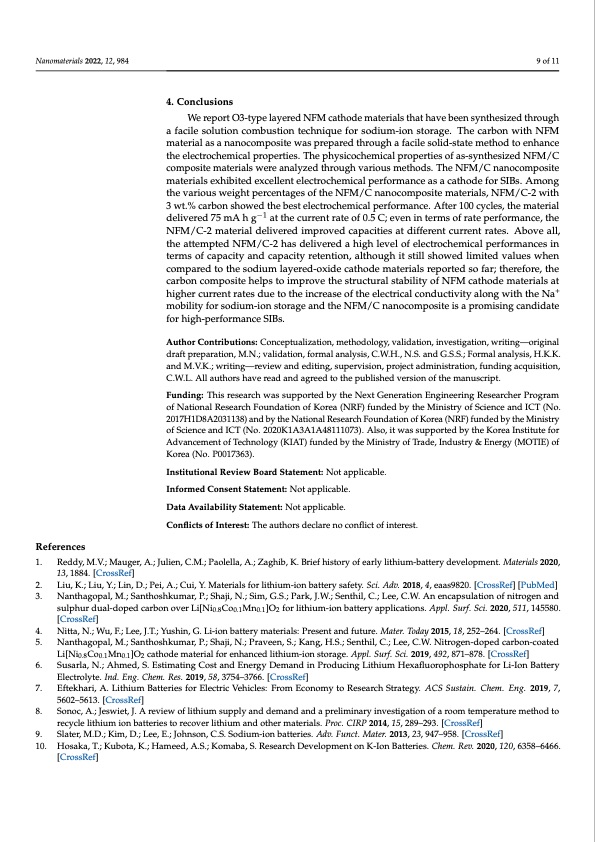
PDF Publication Title:
Text from PDF Page: 009
Nanomaterials 2022, 12, 984 9 of 11 References 4. Conclusions We report O3-type layered NFM cathode materials that have been synthesized through a facile solution combustion technique for sodium-ion storage. The carbon with NFM material as a nanocomposite was prepared through a facile solid-state method to enhance the electrochemical properties. The physicochemical properties of as-synthesized NFM/C composite materials were analyzed through various methods. The NFM/C nanocomposite materials exhibited excellent electrochemical performance as a cathode for SIBs. Among the various weight percentages of the NFM/C nanocomposite materials, NFM/C-2 with 3 wt.% carbon showed the best electrochemical performance. After 100 cycles, the material delivered 75 mA h g−1 at the current rate of 0.5 C; even in terms of rate performance, the NFM/C-2 material delivered improved capacities at different current rates. Above all, the attempted NFM/C-2 has delivered a high level of electrochemical performances in terms of capacity and capacity retention, although it still showed limited values when compared to the sodium layered-oxide cathode materials reported so far; therefore, the carbon composite helps to improve the structural stability of NFM cathode materials at higher current rates due to the increase of the electrical conductivity along with the Na+ mobility for sodium-ion storage and the NFM/C nanocomposite is a promising candidate for high-performance SIBs. Author Contributions: Conceptualization, methodology, validation, investigation, writing—original draft preparation, M.N.; validation, formal analysis, C.W.H., N.S. and G.S.S.; Formal analysis, H.K.K. and M.V.K.; writing—review and editing, supervision, project administration, funding acquisition, C.W.L. All authors have read and agreed to the published version of the manuscript. Funding: This research was supported by the Next Generation Engineering Researcher Program of National Research Foundation of Korea (NRF) funded by the Ministry of Science and ICT (No. 2017H1D8A2031138) and by the National Research Foundation of Korea (NRF) funded by the Ministry of Science and ICT (No. 2020K1A3A1A48111073). Also, it was supported by the Korea Institute for Advancement of Technology (KIAT) funded by the Ministry of Trade, Industry & Energy (MOTIE) of Korea (No. P0017363). Institutional Review Board Statement: Not applicable. Informed Consent Statement: Not applicable. Data Availability Statement: Not applicable. Conflicts of Interest: The authors declare no conflict of interest. 1. Reddy, M.V.; Mauger, A.; Julien, C.M.; Paolella, A.; Zaghib, K. Brief history of early lithium-battery development. Materials 2020, 13, 1884. [CrossRef] 2. Liu, K.; Liu, Y.; Lin, D.; Pei, A.; Cui, Y. Materials for lithium-ion battery safety. Sci. Adv. 2018, 4, eaas9820. [CrossRef] [PubMed] 3. Nanthagopal, M.; Santhoshkumar, P.; Shaji, N.; Sim, G.S.; Park, J.W.; Senthil, C.; Lee, C.W. An encapsulation of nitrogen and sulphur dual-doped carbon over Li[Ni0.8Co0.1Mn0.1]O2 for lithium-ion battery applications. Appl. Surf. Sci. 2020, 511, 145580. [CrossRef] 4. Nitta, N.; Wu, F.; Lee, J.T.; Yushin, G. Li-ion battery materials: Present and future. Mater. Today 2015, 18, 252–264. [CrossRef] 5. Nanthagopal, M.; Santhoshkumar, P.; Shaji, N.; Praveen, S.; Kang, H.S.; Senthil, C.; Lee, C.W. Nitrogen-doped carbon-coated Li[Ni0.8Co0.1Mn0.1]O2 cathode material for enhanced lithium-ion storage. Appl. Surf. Sci. 2019, 492, 871–878. [CrossRef] 6. Susarla, N.; Ahmed, S. Estimating Cost and Energy Demand in Producing Lithium Hexafluorophosphate for Li-Ion Battery Electrolyte. Ind. Eng. Chem. Res. 2019, 58, 3754–3766. [CrossRef] 7. Eftekhari, A. Lithium Batteries for Electric Vehicles: From Economy to Research Strategy. ACS Sustain. Chem. Eng. 2019, 7, 5602–5613. [CrossRef] 8. Sonoc, A.; Jeswiet, J. A review of lithium supply and demand and a preliminary investigation of a room temperature method to recycle lithium ion batteries to recover lithium and other materials. Proc. CIRP 2014, 15, 289–293. [CrossRef] 9. Slater, M.D.; Kim, D.; Lee, E.; Johnson, C.S. Sodium-ion batteries. Adv. Funct. Mater. 2013, 23, 947–958. [CrossRef] 10. Hosaka, T.; Kubota, K.; Hameed, A.S.; Komaba, S. Research Development on K-Ion Batteries. Chem. Rev. 2020, 120, 6358–6466. [CrossRef]PDF Image | NaFe0 Nanocomposite as a Cathode for Sodium-Ion Batteries

PDF Search Title:
NaFe0 Nanocomposite as a Cathode for Sodium-Ion BatteriesOriginal File Name Searched:
nanomaterials-12-00984-v2.pdfDIY PDF Search: Google It | Yahoo | Bing
Salgenx Redox Flow Battery Technology: Salt water flow battery technology with low cost and great energy density that can be used for power storage and thermal storage. Let us de-risk your production using our license. Our aqueous flow battery is less cost than Tesla Megapack and available faster. Redox flow battery. No membrane needed like with Vanadium, or Bromine. Salgenx flow battery
| CONTACT TEL: 608-238-6001 Email: greg@salgenx.com | RSS | AMP |